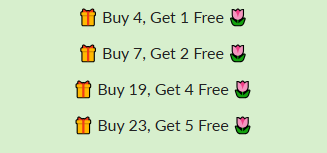
Semillas de rosas en cascada en rojo y blanco
Date prisa, la oferta finaliza en
 Non-GMO Seeds
Non-GMO Seeds
 100% Organic Seeds
100% Organic Seeds
 Money Back if Seeds Don’t Sprout
Money Back if Seeds Don’t Sprout
Cómo cultivar:
Antes de cultivar rosas a partir de semillas, estas deben pasar por un período de estratificación. Se trata de un almacenamiento en frío y húmedo que prepara las semillas para la germinación.
Tratamiento del frío
Enfriar las semillas en el refrigerador durante unas seis a diez semanas las estimula a germinar más rápido una vez plantadas. Sin embargo, debes tener cuidado de no mantenerlas frías durante mucho tiempo, ya que pueden germinar mientras aún están en el refrigerador. Coloca las semillas sobre una toalla de papel antes de humedecerlas. Usa la mitad de agua purificada y la otra mitad de peróxido para evitar el crecimiento de moho. Luego puedes colocarlas en una bolsa de plástico con cierre hermético, marcar la fecha y la variedad antes de colocarlas en un refrigerador a una temperatura entre 1 y 3 grados C. La toalla de papel debe permanecer húmeda durante todo el período. Puedes revisarla de vez en cuando para ver si es necesario volver a humedecerla. Asegúrate de no congelar la toalla.
Existen otras formas de estratificar las semillas, como plantarlas en una bandeja con tierra para macetas y refrigerarla por completo durante semanas. La bandeja suele estar envuelta en una bolsa de plástico para mantenerla húmeda.
Plantando tus semillas
Cuando creas que tus semillas están listas para plantar (entre 6 y 10 semanas), saca la bolsa del refrigerador si ese fue tu método de estratificación. Necesitarás bandejas poco profundas o macetas pequeñas para plantar tus semillas. Cualquier cosa que funcione entre las bandejas y las macetas está bien siempre que tenga un buen drenaje. El tamaño ideal de las bandejas o macetas debe ser de 3 a 4 pulgadas de profundidad.
Puedes utilizar bandejas separadas para plantar semillas de diferentes variedades de escaramujos. Debes seguir las instrucciones de etiquetado desde la cosecha, el tratamiento y la plantación. El nombre del rosal y la fecha de plantación son algunos de los detalles que debes indicar en las bandejas o macetas.
A continuación, llena las bandejas o macetas con la tierra para macetas. Puedes optar por utilizar 50 % de tierra para macetas esterilizada y 50 % de vermiculita, o mitad turba y mitad perlita. Cuando la mezcla para macetas esté lista en las bandejas o macetas, es el momento de sacar las semillas de la toalla. Recuerda que no debes sacar las semillas de la bolsa de plástico hasta que estén listas para ser plantadas. Espolvoréalas ligeramente antes de plantarlas.
Coloque las semillas aproximadamente a ¼ de pulgada de profundidad en la tierra y espolvoree la superficie nuevamente para evitar la enfermedad de la humedad que mata las semillas. Riéguelas adecuadamente y colóquelas afuera, bajo la luz solar directa. Si hay heladas, se recomienda colocar las semillas debajo de un árbol o en una parte protegida del patio para protegerlas. No es necesario usar luces de cultivo.
Mantén las macetas o bandejas de tierra regadas pero no empapadas. No dejes que se sequen ya que esto podría afectar la germinación de tus semillas.
Esté atento a la germinación
Después de unas seis semanas, empezarán a aparecer las dos primeras hojas de las semillas antes de que puedan surgir las hojas verdaderas. La plántula debe tener entre tres y cuatro hojas verdaderas antes de que pueda estar lista para el trasplante.
Plantando tus plántulas
Cuando las plántulas hayan crecido unos centímetros y tengan al menos tres hojas verdaderas, estarán listas para ser trasplantadas. Puedes trasplantarlas a una maceta de cuatro pulgadas de tu preferencia. No tienes que plantar todas las plántulas, sino solo las sanas. Puedes optar por controlarlas en la bandeja y trasplantarlas solo cuando hayan crecido más.
Debes controlar las plántulas a medida que crecen en sus nuevas macetas para comprobar su color, forma, tamaño del arbusto, ramificación y resistencia a las enfermedades. Las rosas con flores débiles, poco saludables o poco atractivas pueden descartarse. Las nuevas plántulas tardarán al menos tres años en alcanzar la madurez y convertirse en un gran arbusto. Sin embargo, la primera flor se podrá ver después de uno o dos años.
*La tasa de germinación depende del país y de las circunstancias climáticas.
Second:💰 Money-Back Guarantee: If you have any quality problems with the product within 30 days of purchase, we will gladly issue out a replacement or refund.
Third:✉️ Customer Support: We have a team of live reps ready to help and answer any questions you have within a 8-hour time frame, 5 days a week.
Fourth:🔒 Safe & Secure Checkouts: We use state-of-the-art SSL Secure encryption to keep your personal and financial information 100% protected.
Every shopping experience is a new experience full of expectations. If there are any problems with the seeds you received or the logistics process, please contact us by email first. We promise to follow up and handle it for you as soon as possible: whether you need to resend the goods or want a refund service, we will respond as quickly as possible. Your satisfaction is our primary pursuit!




